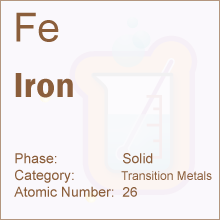 Periodic Table -> Iron
Periodic Table -> IronIron
Iron DetailsIron Symbol: Fe
Iron Atomic Number: 26
Iron Atomic Weight: 55.847
What is Iron?
Iron (atomic number 26, symbol Fe) is a chemical element and a metal belonging to the first transition series. Iron is one of the most common elements in the Earth's crust, and it is abundant in rocky planets, resulting from fusion in high-mass stars. Iron is also the most common element which forms the Earth (by mass), and it forms its inner and outer core Elemental iron is present in low-oxygen environments such as meteoroids, and it is reactive to water and oxygen. While fresh iron is silver-gray and lustrous, it gives iron oxides upon oxidation in normal air. The element exists in 4 crystalline forms and forms two series of compounds – ferrous or bivalent iron (II) compounds and ferric or trivalent iron (III) compounds. Iron dissolves in dilute acids and rusts in damp air.
This metal has been used since ancient times, and beads from iron date back to 3500 BC. Today, the production of steel or iron takes place in two stages, unless cast iron is to be produced. During the first stage of the process, pig iron is produced in a blast furnace. Then, steel or wrought iron is made from pig iron.
The chemical compounds of iron, including ferric and ferrous compounds, have multiple applications. The mixture of aluminum powder and iron oxide, for example, can be ignited, and it creates a thermite reaction. It is used for purifying and welding ores. Binary compounds with the chalcogens and halogens are also formed.
The production of steel, which is an alloy of carbon and iron, requires large amounts of iron. Steel usually contains between 0.3 percent and 1.5 percent of carbon, and this depends on the desired characteristics. Other elements can be added to steel to give it useful properties. For example, when small amounts of chromium are added, it prevents dust and improves durability. Adding nickel improves resistance to acids and heat and increases durability. Molybdenum improves resistance to heat and increases strength while manganese improves resistance to wear and increases strength. When added, vanadium increases springiness and strength, and tungsten helps retain hardness at high temperatures. Steel has many applications and is used to make skyscrapers, paper clips, and anything in between.

In nature, most of the iron is found in the composition of different iron oxides, for example, minerals such as taconite, magnetite, and hematite. It is believed that the core of the earth is made mostly of an iron-nickel alloy. This element is also essential to life on Earth, from humans to microorganisms. It can be found in vegetables, potatoes, whole meal products, and meat. Iron found in animal products is absorbed by the body faster than iron in plant products. This element is an important component of hemoglobin: the blood’s red-colored agent, which transports oxygen. At the same time, if iron remains in the body tissues, it can cause retinitis, choroiditis, and conjunctivitis. The repeated inhalation of iron oxide dusts and fumes in excessive concentrations may lead to benign pneumoconiosis
The production of iron globally reaches more than 500 million tonnes per year. The economically workable iron ore reserves are estimated at over 100 billion tonnes. The major mining sites are found in Ukraine, Russia, Austria, Brazil, and China. In addition, considerable amounts are mined in India, Sweden, Canada, and the United States.
You can
link to this page, using the code below:
Periodic Table |
Banks
© ElementsDatabase.com 2015 | Privacy | About | Contact